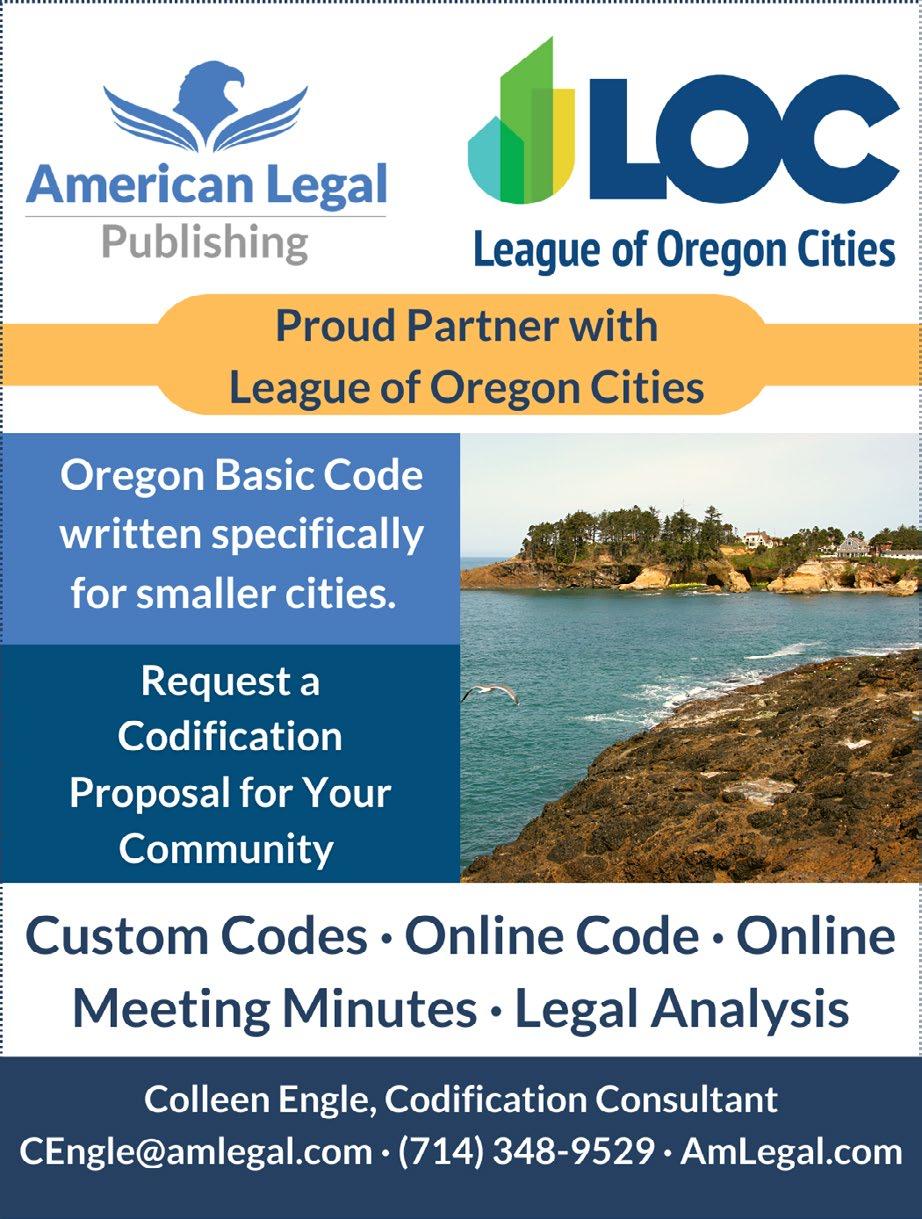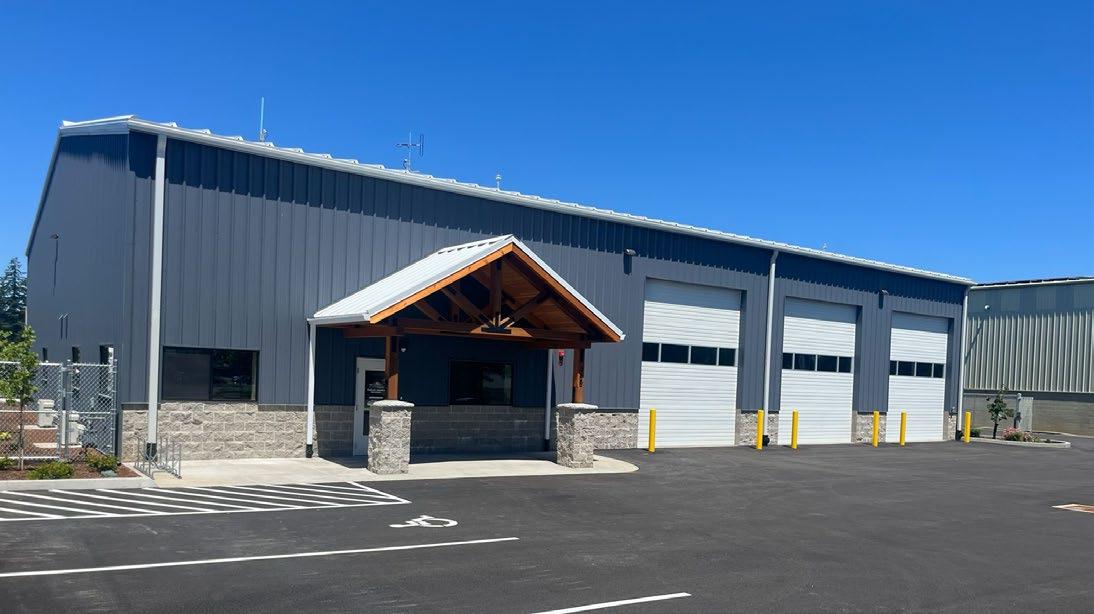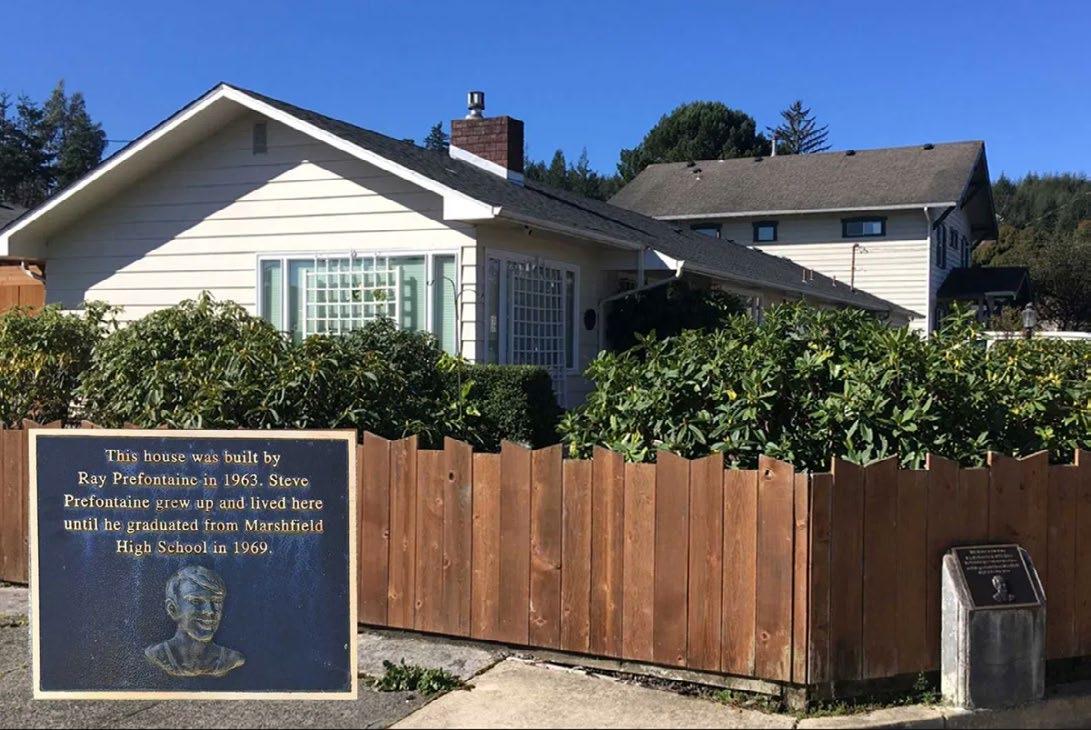













• Tailored Coverage: Our members value our specialized coverage and risk management strategies for cities and counties.
• Cost-Effective: We understand the importance of price in decision-making and prioritize proactive measures to reduce long-term claims costs.
• Community Ownership: Join with other municipalities in our cooperative ownership model.
• Personal Service: Receive personalized assistance with risk assessment, claims, and compliance from our experienced team.
At CIS, we’re not just an insurance company; we’re a risk pool designed for cities and counties. Since 1981, our collective approach has provided tailored coverage and expert risk management services.
Secure your community’s future with CIS. Contact us today!
Experienced risk management | Comprehensive benefits programs | Expert claims processing | Innovative trainings | Strong Property/Casualty coverages For more information contact Bill LaMarche, CIS member relations manager, at blamarche@cisoregon.org.












Play opens the door for connection and the Giant Burke Chair connects everyone together for a memory. Creating memories that last a lifetime is Play That Moves Us. Join Our Movement at buellrecreation.com

Local Focus is published quarterly by: League of Oregon Cities 1201 Court St. NE, #200 Salem, Oregon 97301 (503) 588-6550 • Fax: (503) 399-4863 www.orcities.org
OFFICERS
President
Dave Drotzmann, Mayor, Hermiston
Vice President
Jessica Engleke, Mayor, North Bend
Treasurer
Travis Stovall, Mayor, Gresham
Immediate Past President
Steve Callaway, Mayor, Hillsboro
DIRECTORS
Carol Beatty, Mayor, Maupin
Robert Cowie, Councilor, Chiloquin
Rod Cross, Mayor, Toledo
Aaron Cubic, City Manager, Grants Pass
David Emami, Councilor, Happy Valley
Roberto Escobedo, Councilor, Nyssa
Carol MacInnes, Councilor, Fossil
McKennon McDonald, Councilor, Pendleton
Tita Montero, Councilor, Seaside
Rochelle Roaden, City Manager, Monmouth
Tim Rosener, Mayor, Sherwood
Chalice Savage, Councilor, Cottage Grove
Kenna West, City Manager, Independence
Ted Wheeler, Mayor, Portland
Editor
Kevin Toon, ktoon@orcities.org
Designer
Julie Oke, jmoke@orcities.org
Contributing Writer
Melody Finnemore, precisionpdx@comcast.net
Non-member subscription rate: $96 per year
© BCI Burke Company 2024. 800-266-1250
Published articles and views expressed in Local Focus do not reflect any direct or implied endorsement by the League of Oregon Cities unless specifically stated as such. Publication of any advertisement should not be considered an endorsement of the product or service involved.


The League of Oregon Cities (LOC) Board of Directors is committed to ensuring we remain a trusted partner for leaders at all levels. As your 2024 LOC President, I support amending the LOC Constitution to hold board members to a high ethical standard. Each board member occupies a statewide leadership position and should act accordingly.
The LOC Board recently adopted a Code of Ethics to ensure integrity, fairness, and respect for public trust. This code includes sanctions for violations, up to and including the removal from the board after a due process hearing. I would hope we never need this process. However, the current LOC Constitution does not address this, necessitating the request we are making to amend this section of the constitution.
The proposed amendment aims to allow removal of an LOC board member who violates the Code of Ethics, adding to the
reasons to fill a board member vacancy. This change will help maintain the highest ethical standards within the board, ensuring it continues to serve as a trusted governing body.
I urge each member city to review and vote in support of the proposed amend ment at the LOC Annual Business Meeting on October 19. For questions, please contact LOC’s General Counsel Jayme Pierce at jpierce@ orcities.org or 971-428-7270.

Dave Drotzmann
LOC President; Mayor, Hermiston
1. Why is a Constitutional amendment being proposed?
During the June 21, 2024 meeting of the LOC Board of Directors, the Board adopted a Board Member Code of Ethics to govern the conduct of all members of the Board, similar to codes of conduct found in council rules of procedure. Because the Board wants the code to be meaningful and enforceable, it prefers the code include a sanction which will allow for the removal of a Board member who is found to have violated said code. The LOC Constitution is the document which governs the removal of a person from the Board, and currently, the Constitution does not allow for removal from the Board based on a code violation. In order for the Board’s desired sanction to occur, the Constitution must be amended.
2. How is the Constitution amended?
The LOC Constitution may only be amended at an annual business meeting or at a special meeting called for that purpose and by a two-thirds affirmative vote of the voting delegates present.
3. What is contained in the newly adopted Code of Ethics?
The code expects all members of the Boards to conduct themselves in the following manner:
• Affirm the dignity and worth of local government services and maintain a deep sense of social responsibility as a trusted public leader.
• Be dedicated to the highest ideals of honor and integrity in all public and personal relationships in order that the member may merit the respect and confidence of the elected officials, of other officials and employees, and of the public.
• Serve the best interests of all community members.
• Recognize that elected representatives are accountable to their community for the decisions they make.
• Manage all LOC matters with fairness and impartiality.
• Recognize that public office is a public trust and a member shall not leverage their position for personal gain or benefit.
• Remain dedicated to ideals of honor and integrity. Insist on performance which will merit the respect and confidence of peers and public.
• Emphasize friendly and courteous service to the LOC membership and seek to improve the quality and image of public leadership.
• Handle each issue without discrimination on the basis of principle and justice.
4. Where can I view a copy of the proposed amendment?
A copy of the Constitution with the proposed amendment may be accessed at tinyurl.com/bdfpw4x9. The specific proposed amendment is contained in Article IV, Section 6.
5. When will voting occur?
Voting to amend the Constitution is scheduled to occur at the LOC Annual Business meeting on Saturday, October 19, 2024 at 11:00 a.m. The meeting will take place in conjunction with the LOC Annual Conference held at the Riverhouse on the Deschutes in Bend, Oregon.
6. Who should I contact with questions?
Questions may be directed to Jayme Pierce, LOC General Counsel, at jpierce@orcities.org or at 971-428-7270.
My mom was the person who taught me the importance of using my voice. If I saw something I didn’t like or heard something that made me uncomfortable, she would always tell me the same thing, “Use your voice, Patricia Marie.” She taught me that if I want to see change, or if I want others to see where change may be needed, I need to speak up, say something, do something, participate.
The LOC, at its core, is a member services organization; it will only be successful if its members, all 241 cities and their respective elected and appointed officials, use their voices. The LOC’s Board of Directors has given staff clear direction—make space for all Oregon cities to use their voice, and then listen to and act on what those voices are saying. For the last several years, the LOC has been working hard to make space for all voices, and perhaps even more importantly, to listen to what those voices are telling us, and then move forward as directed by Oregon’s cities.
Inclusivity starts at the top, with the LOC Board of Directors. In 2021, the League’s membership amended the LOC Constitution to require that there be at least one city official from each of Oregon’s 12 regions serving on the board. Immediately after the annual election in 2021, and after each subsequent election, the LOC President identifies which regions of the state, if any, will be unrepresented on the board in the coming calendar year and convenes the LOC Nominating Committee to identify an elected official from those unrepresented regions to serve oneyear terms on the board of directors. Oregon is a big state, with varying landscapes, differing economies, and competing ideologies. By including each region of the state on the board, the LOC gives equal room for voices to be used and makes more informed decisions.
While the LOC Board works on behalf of all cities, to do so effectively it must know what its member cities want prioritized. In 2024, the LOC convened seven policy committees, each with the set purpose of identifying the biggest issues facing cities, and what is needed legislatively to resolve those issues. Each of the seven policy committees was comprised of a range of perspectives, including technical experts, elected officials, and municipal officials who are generally interested in the relevant subject matter. Committees were designed to have a balance between rural, suburban, and urban cities, while simultaneously, as much as reasonably possible, representing all regions of the state. Most policy committees met at least four times over a three-to-four-month period, and all concluded their work with a list of 23 recommended legislative priorities for the LOC to pursue during the 2025 and 2026 legislative sessions.
The 23 legislative priorities recommended by the seven policy committees are now in the hands of the LOC membership for consideration. Each city has been provided a guide outlining the 23 proposed priorities, along with a ballot. Cities are asked to identify their top five priorities from the proposed list. Ballots must be submitted by September 27, no later than 5 p.m. Submitting a ballot with your city’s top five priorities is your city’s way of using its voice. It is your city’s opportunity to inform the LOC Board of Directors of the issues facing your city and your preference on where major LOC resources should be directed during the next two legislative cycles. As the LOC’s executive director, I cannot stress enough how important it is to the LOC, and to me personally, that the board heard from each of Oregon’s 241 cities on where the League should focus its legislative attention. Please cast a ballot, please use your voice.

Patty Mulvihill LOC Executive Director
The LOC is currently soliciting applications for service on its board of directors beginning in January 2025. Applications can be found by visiting the LOC website at www.orcities.org. The application includes information on board responsibilities, what is expected of board members, and the time commitment it will take to serve as a director or LOC Vice President.
The board sets the policy positions LOC takes, including advocacy at the Legislature. It also guides the LOC staff and oversees the budget.
There are three types of board positions open:
1. LOC Vice President. There is one open position for Vice President. The LOC Vice President is one of four board officers who serve on the LOC Executive Committee. The office of LOC Vice President can be held by an elected city official. The Vice President position will expire on December 31, 2025 (but please note the person in that position will automatically ascend to the position of LOC President for calendar year 2026 and serve as the LOC Immediate Past President in 2027).
1. LOC Treasurer. There is one open position for treasurer. The LOC Treasurer is one of four board officers who serve on the LOC Executive Committee. The office of treasurer can be held by an elected or appointed city official and performs the following duties: chairs the LOC Budget and Finance Committees; signs the annual financial statement;
and performs other duties that may be assigned by the LOC President or the board. The term of office is two years, beginning on the first board meeting of the new calendar year following the election.
2. Elected City Official Director Position(s). This year, there are three open Elected City Official Director positions. Elected City Official Directors represent all geographic regions of the state and varied city populations. The term of office for the Elected City Official Director positions is three years, with the term beginning at the first board meeting of the new calendar year following the election.
All applicants should note that they will be required to make a presentation to the LOC Nominating Committee during a publicly noticed meeting on Thursday, October 17 as part of the 99th LOC Annual Conference in Bend. The Nominating Committee will put forward its recommendation to the LOC membership during the LOC Annual Business Meeting, Saturday, October 19.
Candidates for all three offices should know that the LOC Bylaws allow for nominations from the floor at the Annual Business Meeting.
The application deadline for all positions is October 2
Contacts:
Jayme Pierce, General Counsel – jpierce@orcities.org






Alexandra Ring will join the LOC’s lobbying team in September to take on the housing, land use, and homelessness portfolio. She has been with Oregon Housing and Community Services for the last three years as their legislative and government relations coordinator.
Alexandra’s experience also includes serving as district schedular and caseworker for Congressman Kurt Schrader and the Senate Majority Office. The LOC is fortunate and excited to Alexandra join the team with such a great, diverse background.
Alexandra can be reached at aring@orcities.org



Earlier this summer, LOC Lobbyist Ariel Nelson joined the city of Hillsboro as their government relations manager. Since 2019, Ariel directed the LOC’s legislative work related to housing, homelessness, and land use issues. Her accomplishments have left a significant legacy for the LOC and its members, bringing the organization to the forefront of housing issues..
Lindsay Tenes, who joined the LOC at the start of the 2023 session, will be joining TriMet this fall as their state government relations manager. For the LOC, Lindsay held the advocacy role for tax and finance and was often the leading lobbyist who supported economic tools crucial for communities.
Steffany Sweet joined LOC in September 2022 as an administrative assistant and quickly moved into the role of training coordinator within her first six months. Her contributions to the LOC Training and Small Cities programs have significantly impacted both the LOC and our members. We are grateful for her dedication, creativity, and the positive energy she infused into the organization.
The LOC Board of Directors met in Enterprise on June 21 and took the following actions:
• Adopted the proposed LOC 2024-25 Budget;
• Adopted the LOC Board Member Code of Ethics and Violations Procedure proposed by the LOC Bylaws Committee;
• Amended Section 9.B. of the LOC Bylaws as proposed by the Bylaws Committee;
• Amended Section 4.C. 3(b) and (c) of the LOC Bylaws proposed by the Bylaws Committee;
• Added subsection (e) to Section 4.C.3 of the LOC Bylaws as proposed by the Bylaws Committee;
• Amended the LOC Equity Lens as recommended by the DEIA Committee with additional changes requested by the LOC Board of Directors;
• Reappointed Condon City Manager Kathryn Griener to the CIS Board of Trustees with a term beginning July 1, 2024, and ending June 30, 2028.
Contact: Jasmine Jones, Administrative Assistant – jajones@ orcities.org


Earlier this spring and summer, the LOC distributed two critical surveys related to street conditions, and water and transportation infrastructure needs. The reports continue to demonstrate significant unmet needs across Oregon’s cities. The street conditions survey results confirm that a significant number of city street miles are in subpar condition, with 78% of cities rating their roads as fair, poor, or very poor. These findings are consistent with the 2016 survey and show that despite the increase in the State Highway Fund distribution since 2017, local governments still need infrastructure investment. The infrastructure survey report confirmed that the unmet need is estimated at $5.5 billion.



These reports will be presented to the Joint Committee on Transportation as they evaluate the scale of investment needed in Oregon’s transportation infrastructure. Last week, during an Oregon Transportation Commission (OTC) meeting in Florence, the Oregon Department of Transportation (ODOT) estimated the operations and maintenance budget was short an estimated $343 million and that without funding in 2025, it would risk over 1,000 ODOT jobs.
A recent report card from the American Society of Civil Engineers gave Oregon’s entire infrastructure a C- grade. The report found a 36% increase in fatal crashes statewide from 2017 to 2021. Road conditions also received a grade of “C.”
Contact: Jim McCauley, Legislative Director - jmccauley@ orcities.org
The LOC Women's Caucus' podcast features Oregon women in government. The first-of-its-kind production spotlights women who hold elected leadership and staff positions, and is entitled, "Her Own Wings," in honor of the state's motto, "She flies with her own wings."
Listen to Season 1's 15 episodes on the LOC Women's Caucus page, Apple Podcasts or Spotify. Subscribe to be the first to know when Season 2 is released!






We are excited to announce that registration for the 99th Annual LOC Conference is now open! The premier training and networking event for city officials will be held from October 17-19 at the Riverhouse on the Deschutes in Bend.
The LOC Annual Conference is a must-attend event for city officials looking to stay up to date with the latest trends, best practices, and legislation affecting local government. Register by September 13 and save! Register online at www.orcities.org.

Visit www.orcities.org for a detailed agenda. Agenda subject to change
Thursday, October 17
7:00 a.m. – 9:00 a.m. Trade Show & Continental Breakfast
8:00 a.m. – 12:00 p.m. OMA and OCCMA Business Meetings, Workshops and Lunch
8:00 a.m. – 12:00 a.m. Councilors Workshop and Lunch
12:00 p.m. – 1:00 p.m. Trade Show Lunch
12:00 p.m. – 12:45 p.m. People of Color Caucus Business Meeting
12:45 p.m. – 2:45 p.m. Local City Tours
1:00 p.m. – 2:30 p.m. Breakout Sessions
2:30 p.m. – 3:00 p.m. Networking Break
3:00 p.m. – 4:45 p.m. Welcome and Keynote
4:45 p.m. – 6:15 p.m. Welcome Reception
5:00 p.m. – 8:00 p.m. LOC Nominating Committee Meeting
8:30 p.m. – 10:00 p.m. Caucus Mixer
Friday, October 18
7:30 a.m. – 9:00 a.m. Breakfast with Trade Show
8:00 a.m. – 9:00 a.m. Small, Medium and Large Cities Networks
9:15 a.m. – 12:15 p.m. Local City Tours
9:15 a.m. – 10:15 a.m. Breakout Sessions
10:15 a.m. – 10:45 a.m. Networking Break
10:30 a.m. – 4:30 p.m. Media Interactions Workshop
10:45 a.m. – 11:45 a.m. Breakout Sessions
12:00 p.m. – 1:00 p.m. Women's Caucus Business Meeting
12:00 p.m. – 1:30 p.m. Lunch with Trade Show
1:00 p.m. – 4:00 p.m. Local City Tours
1:30 p.m. – 2:30 p.m. Breakout Sessions
2:30 p.m. – 3:00 p.m. Networking Break
3:00 p.m. – 4:00 p.m. Breakout Sessions
6:00 p.m. – 8:00 p.m. Awards Dinner
8:00 p.m. – 9:00 p.m. President's Reception
Saturday, October 19
7:30 a.m. – 9:00 a.m. Breakfast Session - Grants Pass Case
9:00 a.m. – 9:15 a.m. Networking Break
9:15 a.m. – 10:45 a.m. Closing Keynote
10:45 a.m. – 11:00 a.m. Break
11:00 a.m. – 12:30 p.m. Annual Membership Meeting

That’s why we’re here.
Colonial Life helps employees cover costs when the unexpected happens with our accident, cancer, critical illness, disability, hospital indemnity, life, dental and vision insurance.
Life is anything but expected, including our approach to benefits.
For more information, contact your local Colonial Life Independent Agent: Shane Attebery shane.attebery@coloniallifesales.com 541-659-9288 | CA License # 0E81630


The LOC Awards program recognizes great leaders and great projects in Oregon’s cities. LOC members are invited to nominate elected or appointed leaders who have made outstanding contributions to their city for one of the LOC’s prestigious awards. In addition, there are award categories for progressive and innovative city programs and projects.
The deadline to submit a nomination is Friday, September 6, 2024
Do you know of an individual who has made outstanding contributions to your community or to the state of Oregon? Help us recognize their efforts by nominating them for one of the LOC’s Exceptional Service Awards:

Fossil Councilor Carol MacInnes was the recipient of the 2023 James C. Richards Award.
• The James C. Richards Memorial Award recognizes exceptional contributions by elected city officials.
• The Herman Kehrli Award is granted to a city employee who has provided lasting benefits to their community.
• The Mark O. Hatfield Statesmanship Award is presented to individuals who have demonstrated exemplary service that has positively affected the citizens of Oregon.
• The Civic Education Award acknowledges individuals who have demonstrated an ongoing commitment to nurturing civic responsibility in youth.

Local governments are under pressure to reduce their carbon footprints.
Johnson Controls can help municipalities achieve real results with our OpenBlue Net Zero Buildings as a Service.
With Johnson Controls, you can: Meet your net zero carbon and renewable energy goals
• Optimize building performance
• Reduce operational costs Visit us at www.johnsoncontrols.com/OpenBlue or contact David Nellis at 503-858-4757 or david.d.nellis@jci.com.
© 2022 Johnson Controls. All rights reserved.


The City Awards recognize and encourage excellence, innovation, efficiency and great public service in city government. It’s an opportunity for your city to receive the recognition it deserves. Winners can use their success as a positive selling point for their communities and as a boost to the community’s spirit. The awards also serve as a forum for sharing the best public service practices in Oregon.
• The Award for Excellence recognizes cities that have undertaken progressive and innovative approaches to city operations and providing services to their citizens.
• The Helen and Alan Berg Good Governance Award recognizes programs, projects or events which have a specific purpose of reaching out to and/or educating citizens.
Nomination forms and submission instructions, as well as past award winners, can be found on the LOC website at: www.orcities.org.






On May 9, more than 325 local law enforcement, behavioral health, and city and county leaders gathered in Salem for a facilitated implementation and training symposium on HB 4002 titled, “Deep Dive into Deflection & Law Enforcement Assisted Diversion Programs.”
Videos of all presentations and accompanying materials from the entire day are now available.
HB 4002 was passed in the 2024 legislative session, was supported by the LOC and its coalition partners and made significant reforms to Measure 110. The legislation re-criminalized the possession of small amounts of hard drugs, but did so in way that deflects offenders away from the criminal justice system and into treatment services. Counties are eligible for funding under the bill to create deflection programs but applications for those funds must include partnerships with cities as well as other local partners.
Contact: Scott Winkels, Lobbyist – swinkels@orcities.org

The Sustainable Urban Design Framework is a comprehensive approach to addressing sustainability issues that helps simplify a complex field. It brings together topics from architecture, planning, landscape, development, ecology, and many other fields, and organizes them by outcome goals and design scales. The Sustainable Urban Design Handbook is based on this framework and has a chapter dedicated to each of the elements in the framework—bringing together and synthesizing the latest research and professional best practices in an easy-to-understand, graphically rich, and rigorous guide.
Visit the Handbook website for a link to purchase, more on the framework, sample chapters from the handbook, and the original article on the framework published in the Journal of Urban Design.





Each year, the Oregon Department of Transportation (ODOT) evaluates projects for possible state grants through its Small City Allotment (SCA) program. For the 2024 cycle, another $5 million made possible by HB 2017 from the 2017 legislative session is available for funding of up to $250,000.
Incorporated cities with populations of 5,000 or fewer must have all previously awarded SCA projects completed, and reimbursement requests submitted to ODOT before September 1, 2024.
Eligible projects can be on a city street or a county road within a city’s limits, excluding state highways. These projects should improve streets that are inadequate for the capacity they serve or are in a condition detrimental to safety. Pedestrian improvements are also eligible. Additionally, cities can use SCA funding to meet the match requirement for an existing project, provided the primary funding is already secured by an executed agreement.
Cities must submit documentation from area and district managers for approval and agreed-upon maintenance terms with their application. The maintenance agreement must:
• Identify the entity that will be responsible for the maintenance;
• Identify the period they will be required to provide maintenance; and
• Identify what will become of the features when the maintenance period ends.
NOTE: Area and district office approval does not indicate that a project will be selected for funding.
The application period has been extended by 30 days to allow time for this additional process.
Applications and instructions available on the Small City Allotment webpage. www.oregon.gov/odot/localgov/pages/sca_program.aspx
Contact: Jim McCauley, Legislative Director – jmccauley@ orcities.org

August 27:
Election Day: Special
Note: Double majority rules apply for property tax measures.
September 5:
November Election : File Statements of Offices, Candidates and Measures with County
City elections filing officer must file no later than the 61st day before the date of the election. Thursday, September 5 is this year’s deadline to file as it is 61 days before the November 5 election
September 30:



complete copy includes the sample ballot for each new tax and all budget detail sheets, meeting notices and affidavits of publication, resolutions, and ordinances from the budget process.
Note: Although the budget process may begin sooner or later than noted, all the documents referenced above must be submitted to the county clerk by September 30.
As soon as practicable after the end of each calendar quarter, cities that impose a construction tax pursuant to ORS 320.192 shall deposit the construction tax revenues collected in the calendar quarter just ended in the general fund of the city. (ORS 320.195.)
Reminder: Public Employee Retirement System (PERS) Reports
City must remit a regular report to PERS Board no later than three business days after the end of the city’s pay cycle. (ORS 238.705; OAR 459-070-0100.)

Dayton City Councilor Kitty Mackin uses her motorized scooter not only to get around, but also to start conversations. As the first member of the LOC’s Diversity, Equity, Inclusion & Accessibility (DEIA) Committee with a physical impairment, Mackin’s goal is to make sure accessibility is a key part of those conversations.
“The way I understand diversity is focusing on historically underserved communities, and wheelchair users are kind of at the bottom of the list,” she said, adding she wanted to be part of the committee because no one else in her protected class is represented.
Mackin, who clarified that she was not speaking on behalf of the Dayton City Council, described herself as an individual with limited muscle mass who is nearing her 70s. The electric scooter allows her to get around independently, including in her role as a Portland Rose Festival clown named Miss Beverly Bookmark, a “library clown” named in honor of Beverly Cleary.
“I use my wheelchair for performance art, and it’s kind of a reminder that just because there’s a defective body doesn’t mean the brain is toast. I’m here and I can do this too and I want to make you laugh along the way,” she said. “I stand out in the crowd. I’m not shy and I have signs and a little flair. Most people appreciate it.”
Mackin said that when she has attended LOC conferences in the past, her wheelchair-accessible room was separate from the block of rooms reserved for other attendees and the price was higher. She was able to advocate for the same pricing during last year’s 98th Annual Conference in Eugene, but her room was still in a different section of the hotel.
“If I can go to more conferences, maybe I’ll see someone else in a wheelchair. That’s what I’m hoping for,” she said, noting that she looks at the hotel elevators as a chance to talk to a captive audience and make them laugh during the conferences.
Mackin said she appreciates the chance to serve on the DEIA Committee, where she hopes to further its goal of helping the LOC’s Board of Directors do their job through an equity lens and make sure the organization meets the needs of all underserved populations.
“This is an opportunity to tell my story and people appreciate hearing it. That’s one thing I’ve gotten from the committee and the conferences, and people have said thank you for sharing. Well, thank you for listening,” she said.



Since March, the LOC’s seven policy committees have been reviewing and evaluating potential legislative concepts for the 2025 and 2026 legislative sessions. Each committee has held as many as five meetings to evaluate legislative concepts and determine the priority issues for cities to advance during the next two legislative sessions. More than 150 LOC members participated in the committee process, producing 23 recommended legislative actions for the 2025 and 2026 sessions.
Over the summer, all cities in Oregon now have a chance to review the 23 recommendations and select their respective topfive issues by September 27. At the end of the process, all votes are tallied. Voting effectively creates a ranking process among the proposed recommendations. The LOC Board will review the recommendations during its October meeting and determine the top issues the LOC lobby team will focus on. (Remember: those issues not receiving high vote tallies do not drop off the LOC’s advocacy list. Instead, they become part of the overall legislative work during the two-year legislative cycle.)
The LOC’s priority-setting process is unique because every city has the opportunity to help set legislative priorities. We truly have a one-vote-one-city standard in the voting process, and because of the change in how policy committees are selected, we’ve done our best to have voices from all 12 LOC regions, with representation from small and large communities and cities in the rural and frontier areas of Oregon.

Policy committees remain a foundation component of developing a legislative focus on issues that represent the cross-section of the LOC’s membership. Composed of city officials, these groups analyze policy and technical issues and recommend positions and strategies for the League. In addition, LOC staff rely on the input and expertise of committee members as they advocate for city interests at the Legislature and with state and federal agencies.
This year, the policy committee selection process differs from past years. A structured process now aligns with how other LOC committees are formed. Each policy committee was formed based on the applications received and selected to balance representation among large and small cities and their geographic location. The goal was to balance representation across all 12 LOC regions on the committees. In addition, the LOC Women’s Caucus and People of Color Caucus, along with the Oregon Mayors Association and the Oregon City/County Management Association, were allowed to appoint a member to each of the seven policy committees.
The LOC policy committees give advice and make recommendations to the LOC Board of Directors as part of the board’s policy development process. This may include:
Underground leaks may be out of sight, out of mind, but if left untreated, these leaks can take a hidden toll: wasted water, wasted energy and reduced capacity to serve customers. To help make locating and repairing underground leaks more affordable, tap into Energy Trust of Oregon’s cash incentives.
For more information, call 503.928.3154 or visit www.energytrust.org/wastewatertreatment
Serving customers of Portland General Electric, Pacific Power, NW Natural, Cascade Natural Gas and Avista.
We extend our sincere gratitude to the 150 city leaders who generously volunteered their time on the LOC’s seven legislative policy committees this year. Your expertise has been invaluable as we advocate for cities, and we couldn’t do it without you!
A special thank you to the chairs and co-chairs for their leadership and expertise.
• Cathy Clark, Mayor, Keizer – Community and Economic Development Chair
• Megan Perkins, Mayor Pro Tem, Bend –Community and Economic Development Co-Chair
• Melanie Kebler, Mayor, Bend – Energy & Environment Chair
• John Walsh, City Administrator, St. Helens –Energy & Environment Co-Chair
• Heidi Lueb, Mayor, Tigard – General Government & Human Resources Chair
• Robert Cowie, Councilor, Chiloquin –General Government & Human Resources Co-Chair; Broadband, Cybersecurity and Telecommunications Co-Chair

• Participation in the proposal of Oregon Municipal Policy revisions;
• The review of areas to recommend that the League take proactive and defensive positions in the legislative process; and
• Serving as a focus group when necessary to assist staff in assessing policy issues.
The summer is the perfect time for cities to build their relationships with state and federal legislators. The LOC’s advocacy efforts never stop, and cities must recognize that legislative relationships require consistent attention and stewardship. The more your legislators know you and understand what’s important to your community, the better off your community will be. If you have important projects or issues, the summer presents opportunities for tours and a more hands-on approach to advocacy. Having a visual record for you to build will pay off in the end, whether it presents you with state or federal funding, or whether it’s a policy
• Tim Rosener, Mayor, Sherwood – Broadband, Cybersecurity and Telecommunications Chair
• Kenna West, City Manager, Independence –Finance & Taxation Chair
• Don Hudson, Finance Director, Tualatin –Finance & Taxation Co-Chair
• Anthony Martin, Councilor, Hillsboro –Transportation Chair
• Rob Inerfeld, Transportation Planning Manager, Eugene – Transportation Co-Chair
• Niki Iverson, Water Director, Hillsboro – Water/ Wastewater Chair
• Ed Fitch, Mayor, Redmond – Water/Wastewater Co-Chair
issue that provides you the chance to connect with state or federal regulations or policy decisions.
Now that you have the LOC’s new voters guide (tinyurl.com/ LOCVotersGuide), you can use this information to build and develop messaging that fits your community’s unique challenges and potential opportunities. For example, being able to convey the importance of transportation investments in your city and the reliance on the State Highway Fund (SHF) is a simple example that can have a great visual reference. Your street conditions are very much dependent on the SHF distribution, and without additional investment, your streets will become unsafe.
Thank you to every LOC member who served on a policy committee and those who participated in our priority development process throughout the spring. We estimate that at least 150 city represenatives from every LOC region statewide contributed to this effort. Your work is appreciated!










By Melody Finnemore
Cities across Oregon are using artificial intelligence (AI) in myriad ways to help improve efficiency, customer service and communication while reducing the burden of mundane tasks for human staff members. AI also has been found to be a cost-effective business intelligence.
In Independence, for example, AI is used to create content for the city’s social media platforms and other communications. Independence also is exploring the potential to use AI for code review assistance for municipal codes, building codes and others. In that capacity, AI could help identify gaps and overlaps in codes, according to Jason Kistler, the city’s IT director.
At the same time, however, there is plenty of caution to go along with the benefits. Among the issues of concern are bias and discrimination, cybersecurity and privacy, unintentional harm and unrecoverable damage. Kistler and a trio of fellow IT professionals who presented a session on AI and local governments during the LOC’s 2023 Annual Conference shared some of the benefits and potential pitfalls city leaders should be aware of.
During the presentation, generative AI was defined as that which uses algorithms to create new content, including audio, text, images, texts and simulations. Predictive AI predicts outcomes or results using previous examples, such as email’s ability to determine what is spam and what is not.
Through his work in IT and cybersecurity for Independence and other small and medium-sized cities, as well as work supporting local school districts and law enforcement agencies, Kistler

Jason Kistler, Independence IT Director
is seeing a growing acceptance of the positive uses of AI. Over his 25 years in the IT sector, he saw AI become a key piece of cybersecurity early on and, more recently, a tool with broader applications.
“It didn’t really creep up into the mainstream until a year or two ago, and it’s really exploded,” he said. “The more people get exposed to what is commonly on the news, like ChatGPT, I have seen a lightbulb go off for people and they start to think, ‘Well, I could use it for this.’”
Hector Dominguez, open data and privacy coordinator for the Portland Bureau of Planning and Sustainability’s Smart City PDX program, began studying AI in college in the mid-1990s and worked in the private sector before joining the city in 2018. At that point, the city did not have a privacy policy specifically related to AI or anyone dedicated to working on one, so Dominguez partnered with its cybersecurity group to begin crafting privacy principles. They coordinated with the Office of Equity and Human Rights and brought privacy principles to the city council in 2019.
Those principles include automated decision systems, which involves AI but also spreadsheets, models and calculations. It


is just part of Portland’s effort to actively and transparently release public information about how AI is used for decision making, said Dominguez, who is the city’s representative on the State Government Artificial Intelligence Advisory Council.
“We recognized that AI was something that was emerging and something that can be very transformative in general,” Dominguez said. “We see that as a great tool to automate a lot of decisions, identify issues and classify information. Going through all of the information as a human is impossible.”
The city is now using generative AI, which can generate content based on human input and existing data, widely for images, texts and other communication as well as its capacity as an assistive editor. All content ultimately is reviewed by a human before
Generative AI uses algorithms to create new content, including audio, text, images, texts and simulations.
Predictive AI predicts outcomes or results using previous examples, such as email’s ability to determine what is spam and what is not.
it is released to the public.
“Our city provided some guidance and assisted our CEO to put together some basic guidance on how to use generative AI. We really put an emphasis on transparency and letting people know AI was used,” Dominguez said.
Rafeel Wasif, assistant professor of public administration at Portland State University’s Mark O. Hatfield School of Government, College of Urban and Public Affairs, agreed that transparency is essential when local governments use AI.
“They should communicate how they are using strategies with the public because they may lose public trust,” he said. “I would come across it with curiosity, but also with caution. It has a lot of potential and can optimize a lot of things the government does, save time and make things more efficient.”
Wasif noted that cities also are using AI for traffic controls, data analysis and as a tool to optimize law enforcement. In addition to creating content for communications with the public, some cities are using ChatGPT and other chatbots to review policy
(continued on page 22)


Quang Truong, AIA, Co-Founder, UrbanForm
documents and smaller tasks such as sorting documents.
“Every city has its own kind of way of looking at it. A lot of them are using it for customer service. I’ve talked with a few governments that are using it for writing grants,” he said, adding city leaders need to be cautious about using AI for recruiting and hiring people. Wasif pointed to Amazon as an example where gender bias was detected in its AI tool for recruiting. “It depends on the AI tool and humans can correct for some things and conduct audits.”
Among the benefits Wasif highlighted in his presentation at the LOC Annual Conference, he pointed out that AI can enhance many aspects of local governments and reduce both the time and cost of providing government services, and it can enhance citizens’ experiences of working with the government. It can also help smaller governments “catch up” with larger governments. AI cannot replace humans, but if used properly, it can enhance many government functions. But to make it work, it needs constant oversight, audit, evaluation and analysis, according to Wasif.
Quang Truong, AIA, co-founder of UrbanForm, which automates the process of acquiring zoning and development information for architects, builders and developers, said the first step for city leaders is to educate themselves about AI’s potential and capabilities and, specifically, its limitations.
“You can do that fairly easily by understanding the computer principles behind AI. That gives everyone an idea of the risks and the potentials,” he said. “New uses is the billion-dollar question as people figure out this powerful new tool that also has wellestablished and understood applications at the moment. I see it changing a lot of things, but what I see is that a lot of development needs to have to happen as people get a better understanding of it.”
Truong said that a lot of the confusion and fear surrounding AI centers on “hyperbolic comments” about the ways AI can replace humans. He emphasized that AI is a tool that should be wielded by humans to mitigate risks and augment what humans do.
“When we start talking about AI as a tool and something that can help humans rather than something that can replace humans, then we can begin to have a constructive conversation about AI,” he said.
Truong’s presentation during the LOC Annual Conference reported that city employees typically spend 1.8 hours every day searching for and gathering information, which amounts to 9.3 hours or 1.1 days per week. From a development and construction perspective, much of that time is focused on zoning.
Up to 42% of the cost of a multifamily development is attributed to regulations. In Portland’s three metro area counties, there are almost 1,000 different zoning designations. In the city of Portland,
the zoning code went from 250 pages in 1979 to 1,874 pages in 2021. AI can help get information faster and with fewer errors, according to Truong.
Kistler discouraged city leaders from using AI to actually write codes, however. “That’s where you have to be careful. It’s not a direct replacement for a person,” he said, adding concerns about bias in AI mean city leaders should avoid using it to create policies.
Email security is another concern with AI as well as deep fakes that can happen when AI is used for automated phone systems because it sounds more human and friendlier than the standard robotic voice that has traditionally been used.
“We need to put some guardrails around it and not just rely on private industry to do it for us. Security experts need to really look at what the standards are for locking that down and how to do that,” Kistler said. “We always need a human in the loop to check for errors and bias. You shouldn’t blindly trust in it, but it is a very valuable tool.”
Dominguez also warned against using AI for certain types of analysis, specifically predictive analysis, because bias can be embedded in information used to create models which, in turn, are biased.
“Without human intervention and someone overseeing all that, there is always the potential for harm like missing people who need something the city can provide. They could be invisible to our models,” he said, adding predictive models and classification models can lead to false positives and negatives.
As another example, Dominguez said he recently attended a work session in Seattle about privacy, public records and AI. Regarding public records laws, everything that is generated as part of the public record should be overseen by staff because AI software sometimes does not comply with public records laws.
When it comes to cybersecurity, there are concerns about employees who may type something into a prompt and then share information that should not be shared. The city of Portland is looking into more enhanced training for employees in conjunction with the Bureau of Human Resources.
Dominguez recommended that cities start with the basics, such as making sure that employees understand their duties and obligations when it comes to AI, starting with public protections, privacy and public records. The city initiated an AI workgroup in June 2023 that focuses on policies and protections related to IT, cybersecurity, privacy, city attorneys, equity and human resources.
Wasif noted that AI is inherently biased because society is biased. Since society is biased, much of the data AI is trained on contains society’s biases and prejudices, so it learns those biases and produces results that uphold them. For example, an image generator asked to create an image of a CEO might produce images of white males because of the historical bias in unemployment in the data it learned from.
During his presentation at the LOC Annual Conference, he pointed to mortgage approval rates as another example of prejudice in AI. Algorithms have been found to be 40-80% more likely to deny borrowers of color because historical lending data
disproportionately shows minorities being denied loans and other financial opportunities. The historical data teaches AI to be biased with each future application it receives.
AI-driven virtual assistants or chatbots used for citizen services may not be trained to understand or respond adequately to diverse languages, dialects or accents, leading to discrimination in access to government services.
In addition to privacy concerns, generative AI can also occasionally provide responses or extract information from sources that do not exist to provide a prompt answer. This happens because generative AI uses probability-based guessing based on available information to generate its responses. Many employers, including the U.S. Congress, have instructed staff to use generative AI for research during policy development, but not to recommend, make or interpret policy.
Other potential risks of AI include reducing the use of critical thinking if people start over-relying on it, and it still cannot replace human interaction with citizens. Government work is based on citizen trust, so there will always be a need for that human interaction and some tasks will consistently require human supervision
“I would argue that the output of AI still needs to be validated by a human in any task. Any task that is being done by AI should be subjected to human review. We should treat it like a student assistant that isn’t very smart and look over its shoulder to make sure it’s doing the right things,” Wasif said.
The future of AI, for the city of Portland, revolves around how a new generation of AI services can be used for emergency services.
The city is in a pilot program with its 9-1-1 team to explore how AI can improve response times to calls and other services. The pilot is using natural language processing to understand what happens when somebody answers an emergency call, how the interaction is conducted, and the connection with the length of time it took for services to arrive, Dominguez said.
“Slowly we work with vendors in this case and the 9-1-1 team has been able to improve some of their results,” he said, adding the pilot is only in English for now but the city hopes to add Spanish and other languages.
Law enforcement use of AI also has skyrocketed and includes monitoring for distracted drivers, camera and video surveillance of automobiles and their occupants who are breaking laws, and monitoring for illegal dumping. Law enforcement also is increasingly using AI at schools to do weapons checks, such as identifying a gun under clothing without violating a student’s privacy, and gunshot detection that automatically dispatches police to the location of a gunshot.
“I think it will continue to be used more and more. I’ve seen it become more popular with police and law,” said Dominguez, who is a participant in the GovAI Coalition, a collection of cities across the U.S. that are working to develop model AI policies and manuals for cities.
“We don’t have the capacity internally yet and that is another challenge, so how we are doing it is through these networks and collaborations. We are in communications constantly with other cities and we need to keep working together,” he said.
Ms. Finnemore is a Portland-area freelance writer. Contact her at precisionpdx@comcast.net

No rthwest Code Professionals specializes in serving jurisdictions throughout Oregon, Washington, and Idaho with plan review and building inspections. We have been in the code enforcement business for over 40 years. High standards in customer service is a tes tament to our longevity in this industry, and our entire team looks forward to working with you.
• E stablished in 1973
• Currently serving over 50 Jurisdictions throughout Oregon, Washington, and Idaho


By Kirk Mylander, CIS General Counsel
On June 28, the United States Supreme Court ruled 6-3 in Johnson v. Grants Pass that enforcing camping regulations against homeless persons is not a “cruel and unusual punishment.” Local governments can now enforce camping regulations without fear of being sued for violating the Eighth Amendment of the U.S. Constitution.
The Supreme Court’s opinion in Johnson effectively struck down and overruled the underlying Ninth Circuit case, Martin v. Boise
The Ninth Circuit’s decision in Martin had led to widespread tent encampments throughout the western U.S.
Martin held that enforcing camping regulations against homeless people violated the Eighth Amendment’s prohibition on cruel and unusual punishment if there were more homeless people in a city than available shelter beds. However, after Martin was decided and before the Supreme Court struck it down in Johnson, the Oregon Legislature passed HB 3115, which guided local governments on how to keep in compliance with Martin.
With the Ninth Circuit’s opinions in Martin and Johnson now overruled by the U.S. Supreme Court, Oregon legislators from both sides of the aisle are asking if HB 3115 is still necessary, or whether it just gets in the way of local policy makers crafting local solutions.
This comprehensive article will: summarize the Supreme Court’s opinion in Johnson; explain the remaining applicable rules from HB 3115; discuss what will happen next in future court battles and provide resources to help local governments stay out of legal trouble; and provide resources for compliance and lobbying to loosen the restrictions of HB 3115.
The Ninth Circuit first held that camping regulations could not be enforced against homeless people in Martin v. Boise. The Ninth Circuit then expanded Martin with its decision in Johnson v. Grants Pass
Under Martin, the Eighth Amendment means that if there are no “available” shelter beds, it’s cruel and unusual punishment to issue a homeless person any kind of criminal penalty for violating a city’s camping ordinance.
The Ninth Circuit reasoned that because the unhoused have to exist somewhere, fining them for violating camping ordinances is no different than criminalizing their status as a homeless person. This new rule made it very difficult for cities to push homeless individuals into services.
Instead, the ruling empowered homeless individuals to push back at local government. Justice Gorsuch, who authored the decision in Johnson, describes how people in San Francisco who were homeless would cite the Martin case by name when rejecting city services and “as their justification to permanently occupy and block public sidewalks.” Johnson, 603 US ___ at 9 (2024) (citing San Francisco Brief at 8-9).
Within weeks of Martin v. Boise being decided, the same lawyers filed Johnson v. Grants Pass in the U.S. District Court for Oregon. Johnson expanded upon Martin. While Martin only prohibited issuing criminal fines to the homeless, Johnson held that even issuing civil citations to the homeless was a cruel and unusual punishment that violated the U.S. Constitution.
The city of Grants Pass’ single homeless shelter was never more than 60% full. Despite that, the trial court held that there were no “adequate” shelter beds available. The court observed since the city’s only shelter was operated by Gospel Rescue Mission, and included a religious component, it was not “adequate” for everyone. Some people did not want to be exposed to a religious message. A second way that Johnson expanded Martin was by finding that homeless individuals did not have to wait until they were cited or prove that no shelter bed was available to sue the city. Instead, all homeless persons could join together in a single class action lawsuit and sue the city preemptively. It was then the city’s burden to prove that “adequate” shelter beds were available for everyone.
Finally, Johnson expanded Martin by giving homeless persons not only immunity from camping laws, but also an affirmative right to protection from the elements. In other words, Martin ruled you can’t cite someone who has no place to go. Johnson said they were also entitled to protection from the elements as well.
The Ninth Circuit rulings left local government officials and law enforcement paralyzed, creating an unmanageable focus on “adequate” daily shelter space. Cities wishing to enforce camping regulations had to count the number of involuntarily homeless people each evening and then how many shelter beds were available. Additionally, each shelter bed had to be matched to each homeless person. Shelter space didn’t count if the shelter didn’t allow pets and the person had a dog, or the shelter didn’t allow smoking and the homeless person used cigarettes, or the shelter was organized by a religious organization and the homeless person didn’t want to be exposed to a religious message.
Practically speaking, matching the various needs of the homeless to the different types of shelters and keeping a daily count of available beds was an overwhelming task for any city. Local government could no longer compel homeless individuals to use services, resulting in widespread tent encampments.
Because this unworkable rule tied the hands of local officials throughout the western United States, there was widespread frustration with Martin and Johnson. CIS encouraged the city of Grants Pass to petition the U.S. Supreme Court to review the case. After that, something remarkable happened.
(continued on page 26)
From Smart Building Services to Central Utility Districts, MacDonald-Miller has the tools, talent and technology to help you become a NET ZERO HERO.
We maximize project budget dollars and reduce operational burden on your staff. You can rest easy, knowing we’ll be by your side every step of the way, as we extend the life expectancy of your equipment by over 30%, and improve the comfort of your occupants, all while maximizing energy efficiency.
Achieving carbon neutrality isn’t just good for the environment, it’s SUPER!
We make buildings work better.












You can be a





































Amicus briefs were filed by numerous entities including:
• National League of Cities;
• League of Oregon Cities (LOC);
• Association of Oregon Counties (AOC);
• Special Districts Association of Oregon (SDAO);
• California Governor Gavin Newsom;
• San Franciso Mayor London Breed;
• League of California Cities;
• Association of Idaho Cities;
• League of Arizona Cities and Towns;
• North Dakota League of Cities;
• Cities of Anchorage, Seattle, Spokane, Tacoma, Portland, San Francisco, Los Angeles, San Diego, Las Vegas, Phoenix, Albuquerque, Honolulu, Colorado Springs, Milwaukee, Providence, and Saint Paul;
• District Attorneys of Sacramento and San Diego;
• California State Sheriffs Association;
• California Police Chiefs Association;
• Washington State Association of Sheriffs and Police Chiefs; and
• 20 Different States, and more.
In fact, there was a record number of friend-of-the-court briefs filed in support of Grants Pass’ Supreme Court petition. In response, the Supreme Court not only granted review but made clear that the court heard what cities and counties were saying.
On April 22, 2024, the Supreme Court heard oral arguments on the case. The focus was not on who should do what but on interpreting the Eighth Amendment. They debated whether it was cruel and unusual punishment under the Eighth Amendment to ticket, fine, or jail someone repeatedly trespassing on city property because they were homeless and had “nowhere else to go.”
The issue for the court was whether the Eighth Amendment regulates the type of punishments applied to a crime or whether it regulates what types of behavior can be considered a crime.
Those in favor of upholding the Grants Pass case argued that the Eighth Amendment prohibits punishing someone for their “involuntary” status, such as homelessness, deeming it cruel and unusual. The opposing side contended that the Eighth Amendment only addresses the type of punishment, not the status of the person being punished.
The Eighth Amendment, the Supreme Court ruled, addresses methods of punishment, not who can be punished. The punishments in question were a ticket, a small fine, or very short jail terms. The court found none of these to be cruel and unusual. In fact, these are commonly used punishments across the country. The other side argued that these punishments were cruel and unusual as applied to the homeless. But the majority opinion maintained that the Eighth Amendment regulates types of punishment, not who can be punished.
The court specifically found that the Ninth Circuit inappropriately limited local governments’ tools for tackling the homelessness issue. In so doing, the court recognized that homelessness is a multifaceted problem not suited to a single policy. The opinion
emphasized that decisions on how to address homelessness should be left to community leaders, not judges:
“Homelessness is complex. Its causes are many. So may be the public policy responses required to address it. At bottom, the question this case presents is whether the Eighth Amendment grants federal judges primary responsibility for assessing those causes and devising those responses. It does not.” Johnson, 603 US ___ at 34 (2024).
The court observed the historical tradition of communities working hard to solve difficult social issues, then stated:
“If the multitude of amicus briefs before us proves one thing, it is that the American people are still at it.” Johnson, 603 US ___ at 34 (2024).
The opinion quoted extensively from the League of Oregon Cities’ amicus brief, highlighting Oregon’s specific concerns. Our local concerns were heard by the Supreme Court, thanks to the collective efforts of government officials throughout the western states (even throughout the nation) contributing their voices and resources through amicus briefs that told real stories of the struggle to address homelessness under a one size fits all approach mandated by the Ninth Circuit.
The Supreme Court concluded by stating that the Ninth Circuit opinion in Johnson was reversed, and the Eighth Amendment does not prevent local officials from crafting unique solutions to homelessness. However, the case was sent back down as there were other issues beyond the Eighth Amendment to be addressed.

When it comes to obesity, support employees with The Weigh Forward
Losing weight and keeping it off is hard because of how my body reacts to weight loss. Making a weight-management plan with my healthcare provider is important to my success—as is having coverage for an antiobesity medicine because they can help me lose weight and maintain it!
Employers play an important role in providing access to treatment for employees with obesity
Before the Supreme Court ruled, the Ninth Circuit prohibited all enforcement of anti-camping ordinances against “involuntary” homeless persons when there was no “adequate” shelter. For practical purposes, this vague rule left local officials with no enforceable rules at all.
Now, after the Supreme Court’s decision, Oregon is left with a less restrictive statute. HB 3115 requires camping regulations to be reasonable as to time, place, and manner. For practical purposes, that means:
Reasonable time restrictions: Allow a homeless person to shelter during traditional sleeping hours. The middle ground would be from sundown to sunrise. A 24-hour prohibition on camping will be deemed unreasonable.
Reasonable place restrictions: Camping can be banned from some specific places, such as parks where children often play, central downtown parks, around schools, hospitals, some government buildings and residential areas. However, there needs to be someplace a homeless person can go to sleep for the night.
Some regulations only specify where homeless persons cannot camp. Other regulations specify one specific place that homeless persons can camp. Either way can be reasonable, but there must be somewhere they can sleep overnight—under HB 3115, leaving no options is an unreasonable option, and will result in a lawsuit.
Reasonable manner restrictions: To pass the reasonable test, “manner” restrictions must allow for a homeless person to use some form of protection against the elements. Banning even so much as a blanket or sleeping bag is not reasonable. Tents, tarps, stoves, fires… all these things may or may not be reasonable depending on the weather. But none of these things need to be allowed permanently.
Examples: For instance, “manner” restrictions may allow a homeless person to sleep in a tent, but “time” restrictions mean that person must take down the tent in the morning and allow the park to be used by the general public during the day. Likewise, “place” restrictions mean that a person cannot put up a tent anywhere in town. There may be places where tents are prohibited, or there may be one specific place where tents are allowed.
One thing we know for certain, with Johnson v. Grants Pass now overturned by the U.S. Supreme Court, local control has returned. Community leaders are no longer in danger of being sued for the “cruel and unusual punishment” of requiring everyone to abide by camping regulations. Unique local problems deserve unique local solutions. Your city and county officials are now free to craft reasonable camping regulations. You get to decide what is best for your community.
1. Revisiting HB 3115: The League of Oregon Cities and the Association of Oregon Counties want to hear from their members about House Bill 3115 and Oregon’s time, place and manner regulations. Does it provide helpful guidance, or with the federal courts out of the issue do you want more leeway for cities and counties to handle issues locally?
2. Legal Guide From LOC: The LOC just released an updated homelessness legal guide (tinyurl.com/HomelessGuide) for its members.
3. Camping Ordinance Review: CIS members can get a free legal review of a draft camping regulation. Contact CIS General Counsel Kirk Mylander for authorization: kmylander@ cisoregon.org
4. Further Education: The LOC’s Annual Conference will feature a session dedicated to Johnson v. Grants Pass and homelessness on Saturday, October 19. More information on the conference is on the LOC website at orcities.org
Kirk Mylander is CIS' General Counsel. His previous work experience includes serving as a Litigation Attorney at Miller Nash LLC, and he taught business law while an Adjunct Professor for George Fox University’s MBA Program. Kirk earned his B.A. from George Fox University, his master’s degree from Yale University, and received his J.D. from the University of California at Davis.

Program + Project Management
Cost Management + Estimating Planning + Scheduling
cumming-group.com
In 2017-2018, the city of Aumsville faced many challenges. Negative community sentiment was looming over any increased fees to residents as the city struggled with aging infrastructure, and elected officials faced strained operating budgets and a council recall for imposing a $12 public safety fee that was necessary to maintain the police department. City leaders knew what they needed to do, but the difficulty would be in gaining community support for the changes to come.
The city began working on a community-wide vision plan starting in 2015, when more than 100 community leaders and leadership from the University of Oregon Planning, Public Policy and Management Department participated in a brainstorming project. The end result was a planning document called a charrette, which provided valuable insight into what could be possible in this small, rural city. It was necessary to bring the community into alignment, and the visioning process was able to accomplish that goal.
In 2017, Aumsville City Council and Planning Commission leaders held several meetings and outlined the city’s visioning goals and priorities. This process identified that the city was behind in implementing capital improvement plan (CIP) projects. To address this deficiency and ensure that future projects aligned with the new vision, the city began revisiting its CIPs.
To add to the already mounting needs identified that year, the federal Environmental Protection Agency had made changes to its standards for effluents discharge in tributaries. It took enforcement action against Aumsville’s wastewater system, which did not meet those standards. While this project was not originally discussed during the visioning, it quickly became the most urgent issue to be addressed.
Significant upgrades and improvements were going to be necessary, so the city revamped its CIP to meet the new standards. It also took another look at its public involvement process and how it communicated with its residents.
“We had a lot of community involvement in 2017-2018 around some decisions the council had made, and it wasn’t always positive,” said Aumsville City Administrator Ron Harding. “We learned from that process that it was really important for us to engage the community at a much higher level than we had been. We needed to have a concerted visioning effort where we really involved the community.”
The city’s communication goals were to explain the problems to the residents, inform them of the steps already being taken and include them in ongoing decisions for solutions.
The city held community-wide meetings and formed an 18-member visioning committee to help create concept statements and strategic planning. These developed into Aumsville’s Vision 2040 Plan, which identified six focus areas. These encompass: livable

neighborhoods; a vibrant downtown and healthy economy; inclusive events and celebrations; public art and community branding; civic engagement and communications; and excellent public facilities and infrastructure.
“A lot of the discussion through that process, since we had a captive audience, was expressing concern over infrastructure and the need for really focusing on some pieces of critical infrastructure before we had a critical failure,” Harding said.
In 2020, the city formally adopted its 2040 Vision Plan while it continued working to incorporate and update its CIPs. With support from the community, staff and council began to take action solidifying a clear financial strategy to replace or upgrade the highest-priority water, sewer and storm drainage facilities. City leaders met with officials from the Oregon Department of Environmental Quality (DEQ) to identify those highest on the priority list and, ultimately, plans for a new $30 million wastewater facility emerged.
It was important to the council that a strategy was developed for communicating with residents to keep them informed. Community-wide events such as annual festivals and summer programs were used to drive residents to CIP project information. The city used transparency and honesty to gain the community’s attention, informing residents that their utility bill would likely increase to $300 a month if the project was funded entirely with loans.
CIPs don’t necessarily grab people’s attention, but when the problem is clearly stated and they see how it impacts them directly, they tend to want to get involved in solving it, Harding noted.
“For a small community of 4,200 people to just add a $30 million wastewater facility into the mix, with a seven-year window for completion, just added to the conversation,” he said.
“We deployed a multimedia outreach plan, so we couldn’t just focus on social media, mail notices or public notices. It really had to be everything at our disposal,” he said, adding the public education and outreach effort included creating a petition that stated the increase in utility bills would create financial difficulties for most residents and requested their assistance and support

with grants and other forms of funding to reduce that burden. In the end, of the city’s 1,300 households, 900 individuals signed the petition.
“What we were able to do was convert residents from somebody who is just aware of the problem into someone who is part of the solution. In effect, they all became stakeholders,” Harding said. “It also took the city out of the adversarial role and, by showing such a swell of community engagement, it helped us tell the community’s story, which I believe helped access grants.”
Kirsti Pizzuto, Aumsville’s assistant city administrator, said the education and outreach campaign also included notices mailed out in utility bills, sign-ups at community events, postings on the city’s social media platforms, and the mayor and city councilors going door to door to recruit petition signers.
“We tried to make information as accessible as possible. We also had everything in Spanish, so even if you didn’t speak English you knew about it,” she said. “The effort created stakeholders while it made people more aware, and residents even offered to go door to door.”
Harding said that Aumsville’s CIP identified many priority pieces of its infrastructure needs, including a new $4 million water reservoir, new wells, water system upgrades and a new public works facility. Through its efforts, the city was able to get about 90% of the reservoir and well project grant funded. About 50% of its new public works facility was funded by grants, and the city has completed several road projects under the CIP with grants.
Harding described the wastewater facility as “monumental,” noting it initially seemed unattainable for a city of Aumsville’s size. At the same time, city leaders knew they had to be proactive. The governor’s Regional Solutions team representative for the area, Jody Christensen, organized a statewide stakeholders’ group that included all of the state’s funding agencies, and it invited Oregon’s congressional representatives and staff to meetings so the project would be a priority at all levels.
“We really just talked about the project and what the funding opportunities were,” Harding said. “It also worked as an ability for us to have conversations directly with leadership at DEQ. This prioritized things like getting our updated sewer CIP approved through DEQ because once we had a project that was identified as a solution to meet the standard, we had to go to DEQ for approval.”

With a compliance schedule set, the city would face high fines if milestones were not met on time. To avoid incurring additional costs, city staff used all available tools to their advantage. They spoke with representatives from the DEQ, the U.S. Department of Agriculture and Business Oregon during the Regional Solutions team meetings, and the representatives were very supportive and helpful in identifying resources that would position the city for success.
In addition to being aware of funding packages that filtered down through state agencies, Aumsville’s leaders had an eye on when the 2020 Census data would begin being used by funding agencies.
“We were able to plan the project out to take advantage of the best possible funding possibilities by timing the funding applications, which helped us leverage for favorable terms. That was really advantageous for us,” Harding said.
Over the course of just four years, Aumsville was able to grant fund $6 million in water, road and facility projects, and ultimately received about $19.5 million in grant funding for the wastewater facility project along with low-interest loans. The facility is now in the final design phase, with construction expected to begin in late 2026 and be completed within the following year or two.
When asked what advice he would give to other cities in similar situations, Harding offered these suggestions: “Once your approved CIPs are set, develop a plan to engage your community. Don’t just inform them of the plan. Provide problem statements and test your CIP solutions to make sure the conversation is two-way. Develop fun engagement opportunities to involve residents. Develop stakeholder groups and make sure you have engaged everyone, including your state and federal representatives. State agencies are often the enforcement branch, but they can be partners as well. I cannot stress enough the benefits of these partnerships.
“Ensure you have buy-in from your elected officials and make sure your elected officials have buy-in from the community,” he continued. “Don’t set a course so rigid you cannot take advantage of opportunities when they present themselves. We looked at every opportunity no matter when it presented itself.”
Generally, each city, with a few exceptions, is required to undergo a financial audit at least once each calendar or fiscal year. The audit must be completed by either an independent accountant who is listed on a roster maintained by the Oregon Board of Accountings or by the Oregon Secretary of State’s office. In addition to the annually required audit, the governing body or executive officer of any city may call for additional audits.
Audits are required to inquire into the following2:
• Methods followed by a city in recording, summarizing, and reporting its financial transactions and financial condition;
• Accuracy and legality of the transactions, accounts, records, files, and financial reports of the officers and employees of a city as they relate to fiscal affairs;
• City’s compliance with the requirements, orders, and regulations of public officials which pertain to the financial conditions and operations of the city;
• City’s compliance with the legal provisions of federal laws, state laws, charter provisions, court orders, ordinances, resolutions, and rules and regulations issued by any governmental entity; and
1 ORS 297.425.
2 Id.; OAR 162-010-020.
• City’s compliance with programs wholly or partially funded by federal, state, or other local government agencies.
Audits are to be prepared in compliance with standards established by the secretary of state. In addition to complying with said standards, each audit is required to include the names, mailing addresses, and titles of the officers and members of the city’s council or commission. The name and contact information of these officers and members are to be located immediately on the front cover of the audit.
At a minimum, the secretary of state requires the following to be included in any city audit:
• An individual schedule of receipts/revenues, expenditures/ expenses, and changes in fund balances/net position, budget and actual, for each fund of the city for which budgets are legally required;
• A comparison between the estimated and the actual revenues or receipts, transfers in, expenditures or disbursements, transfers out and ending balances on the basis of the legally adopted budget;
3 ORS 297.465; OAR 162-010-020.

• If the city has made appropriations in a manner which differs materially from the presentation of estimated expenditures in the budget document, a separate schedule must be included which compares actual expenditures/expenses with the legally adopted appropriations;
• A schedule of accountability for each independently elected official collecting or receiving money on behalf of the city;
• Appropriate comments and disclosures relating to the independent auditor’s review of fiscal affairs and compliance with legal requirements;
• Comments regarding the city’s compliance relating to shortterm and long-term debt;
• Comments regarding the city’s compliance with the legal requirements relating to the preparation, adoption and execution of the annual or biennial budget for the year being audited;
• Comments regarding the city’s compliance with the legal requirements relating to the preparation, adoption, and execution of the budget for the next succeeding year;
• Disclosure of the financial or organizational level at which the city’s governing body makes its annual appropriations;
• Comments regarding the city’s compliance with the legal requirements and the city’s policies relating to insurance and fidelity bond coverage;
• Comments regarding the city’s compliance with appropriate laws, rules, and regulations pertaining to programs funded wholly or partially by other governmental agencies;
• Comments regarding the city’s compliance with the legal requirements pertaining to the use of revenue from taxes on motor vehicle use and fuel;
• Comments regarding the city’s compliance with the legal requirements pertaining to the use of road funds;
• Comments regarding the city’s compliance with the legal requirements pertaining to the investment of public funds; and
• Comments regarding the city’s compliance with provisions of the state’s public contracting code regarding the awarding of public contracts and the construction of public improvements4.
Cities are required to submit their audits to the secretary of state within six months of the end of the calendar or fiscal year applicable to the audit. The secretary of state is permitted to give an extension of time if good cause is found; however, the extension of time is not to exceed one year5.
The submission of an audit (including a federal audit) to the secretary of state requires the payment of a filing fee. Based on a city’s total expenditures, the filing fee is to be paid as indicated below6:
4 OAR 162-010-0240 - OAR 162-010-0310.
5 ORS 297.465.
6 ORS 297.485 (amended by House Bill 2110 (2023) and effective January 1, 2024).
(continued on page 32)

$0 $50,000 $40
$50,000 $150,000 $80
$150,000 $250,000 $150
$250,000 $500,000 $250
$500,000 $1,000,000 $300
$1,000,000 $5,000,000 $350
$5,000,000 $10,000,000 $400
$10,000,000 $50,000,000 $450
$50,000,000
$500
Upon receipt of its audit, the city is required to first provide copies of the audit to each member of its governing body who was in office during the applicable year of the audit and who currently holds office. The city is then required to review the audit to determine if any deficiencies in the city’s financial operations were found. Should a deficiency have been found in the audit, the city is required to put forward a plan for rectifying
7 ORS 297.466.
these deficiencies—the plan must contain estimated deadlines for compliance. The city’s plan must be submitted to the secretary of state within 30 days of having submitted its audit. If the secretary of state disagrees with the city’s plan, it can reject it. Should a rejection occur, the city can request a conference with the secretary of state.
In the event a city fails to submit an audit, or fails to comply with a plan to fix deficiencies found during a prior audit, the secretary of state can file a certification of these failures with the state treasurer, director of the Oregon Department of Revenue, the director of transportation, and the director of the Department of Administrative Services. Upon receipt of such a certification, these state departments and agencies are to withhold 10% of the monies that would otherwise be distributed to the city from their respective departments and agencies. Cities are entitled to object to the secretary of state’s certification and will be provided with a hearing prior to the funds being withheld.
Some cities in Oregon have created, via their charters, boards or commissions (whose members are elected by the public) to operate water or electric utilities. These water and electric utilities are required to undergo an audit separate from the city. The same audit requirements applicable to cities and discussed above are applicable to these utilities.
8 ORS 297.466.
9 ORS 297.527.

There are two instances in which a city is exempt from having to undergo an audit.
The first occurs when all three of the following conditions are met:
• The city’s total expenditures in the calendar or fiscal year did not exceed $250,000 (expenditures include money expended for debt retirement);
• The city has submitted financial statements for the applicable year to the secretary of state within 90 days following the end of the calendar or fiscal year; and
• The submitted financial statements included a certificate stating the principle responsible officer of the city was covered by a fidelity or faithful performance bond for the entire year (the bond amount had to at least equal the total amount of money received by the city for that year).
A second instance in which a city is not required to undergo an audit occurs when all three of the following conditions are met:
• The city’s total expenditures in the calendar or fiscal year exceeded $150,00 but did not exceed $500,00 (expenditures include money expended for debt retirement);
• The city has submitted financial statements for the applicable year to the secretary of state within 180 days following the end of the calendar or fiscal year, with said statements having been reviewed by an accountant approved by the Oregon Board of Accountancy or by the secretary of state; and
• The submitted financial statements include a certificate stating the principle responsible officer of the city was covered
10 ORS 297.435 (amended by House Bill 2110 (2023) and effective January 1,
by a fidelity or faithful performance bond for the entire year (the bond amount had to be at least equal to 10% of the total receipts of the city for the year, but in no case can the bond amount have been less than $25,000).
These audit exemptions are not applicable if the secretary of state receives a petition requesting an audit from the city’s citizens11 The petition for a city with a population of less than 150 residents must contain the signatures of at least 10 residents. A petition for a city with a population of 151 or more residents must contain the signatures of at least 30 residents. Regardless of the number of signatures needed, the petition must be submitted to the secretary of state within six months of the end of the calendar or fiscal year. Should the secretary of state receive a qualifying petition asking for an audit of an exempted city, the secretary of state will notify the city of the petition within 10 days of the petition having been filed12. Upon receipt of the secretary of state’s notice, the city will have 30 days to take one of two actions: (1) enter into a contract with an approved accountant to perform a state audit; or (2) pass a resolution asking the secretary of state to perform a state audit.
For additional resources:
• Oregon Secretary of State FAQ and Answers (sos.oregon.gov/ audits/Pages/muni-faq.aspx);
• Oregon Secretary of State Municipal Audits Local Government Resources (sos.oregon.gov/audits/Pages/local-governmentresources.aspx; and
• LOC FAQ on Municipal Audits (www.orcities.org/download_file/131/1852). .
11 ORS 297.445.

Serving Utility Sectors and Private industries for 25 years


Good things our cities have been doing all across the state.

Former Rockaway Beach Mayor Sue Wilson cuts the ribbon at Anchor Street Park
Summer Solstice was the perfect day for the ribbon-cutting ceremony at the new Anchor Street Park, and children raced toward slides, a merry-go-round and a climbing apparatus as soon as former Mayor Sue Wilson completed the honor.
“This project includes the installation of a new two-unit restroom facility, two new playgrounds, event space with utilities and parking for 43 vehicles,” City Manager Luke Shepard said during the ceremony.
Noting that Rockaway Beach can always use more parking, Mayor Charles McNeilly added, “this started as a line item in the transportation plan. A few years ago, it was picked up by former Mayor Wilson and put on the administrative task list, and then handed over to City Manager Luke Shepard to make this come to fruition.”
Rockaway Beach Public Works put down 37,000 pounds of fall protection rubber matting, and the entire park is ADA compliant and accessible to everyone. The park also features a designated pet area, according to the Tillamook County Pioneer.














Enhancing La Pine’s advantages in attracting new investments, the city recently announced that a small business incubator will be located in its 330-acre industrial park. City Manager Geoff Wullschlager said the incubator will be about 5,000 to 8,000 square feet and will house up to seven tenants.
Each tenant will receive: technical assistance for starting a business; individualized business counseling in collaboration with Central Oregon Community College’s (COCC) Small Business Development Center; collaboration with business resources at the Deschutes Public Library; business plan assistance; and guidance with financing for start-up and growth.
In addition, the incubator will provide: mentoring assistance on concept, critical expertise and strategy; assistance in marketing, export, government procurement and workforce development; increased networking opportunities; and access to potential investors and partners.
In order to facilitate local workforce development, COCC – in partnership with the La Pine Parks & Recreation Department –is in talks to create a mobile unit offering both pre-construction classes and an apprenticeship program that will give job seekers a variety of certifications.

“Education can be delivered in lots of different ways, not just traditional settings,” said Patricia Lucas, executive director of Sunriver-La Pine Economic Development (SLED). “I’m excited about the potential of this approach.”
SLED currently has 11 projects in the economic pipeline that involve health care, consumer products, forestry, alternative energy, advanced manufacturing and fabrication. With one involving a multistate company, the projects represent an estimated privatesector investment in new capital of $44.5 million, totaling 63,400 square feet of building space and the creation of at least 58 new jobs.

Monmouth officials introduced the city’s new logo in council chambers in early July, drawing rave reviews from staff members and residents alike. Designed by Altar Media of Independence, the logo features bright colors, fields, hills, sun and silhouettes of trees, along with the words “Monmouth Oregon” and “Where Great Things Grow.”
“This logo represents the vibrancy of our community and the love we have for the landscape. The array of colors speaks to our inclusivity, energy, growth and diversity of the Monmouth community,”
Sabra Jewell, the city’s communications coordinator, told people who attended the unveiling. “We hope that you enjoy this new logo for years to come and are proud to say that you live and play in Monmouth, Oregon. Where great things grow.”
The new logo promotes consistency in messaging as well. Jewell said the old logo was not consistent from department to department, and she noted that first impressions are important, as is consistency with branding, reported the Polk County Itemizer-Observer.
“When someone is looking at where they want to work and live and start a business, they’re looking for that kind of quality,” Jewell said. “So, part of the driving factor for us was to just kind of elevate our brand in a way that this town really deserved.”
The process took months and included input from many people. A community survey was done and a committee sorted through the responses to determine what traits needed to be conceptualized on the logo. City councilors and department heads offered their feedback as well.

Mayor Cec Koontz noted the committee was diverse and included established and new members of the community.
“The fun of this project happened in this room as a small group,” she said. “…the small group that criticized, dreamt big, big pictures of what we thought this should look like and how to best represent ourselves to the outside world.”

On May 13, the city of Gladstone celebrated the grand opening of its new public works facility, just nine months after groundbreaking on the critical building that will ensure better resilience during emergencies.
New generators were installed, and the public works department will be operable and able to respond immediately to any natural disaster’s impacts on the city’s infrastructure. By consolidating operations into a modern facility, residents can expect more efficient and effective services from the department, according to the city.
The 5,000-square-foot facility houses a reception area, offices, crew rooms, a conference meeting room, lunch room, genderneutral locker room, janitorial and supply storage, restrooms, and a laundry room for hazardous cleaning. The upgraded facility eliminates the need for a temporary modular building that had been rented for staff.
Voters approved the project without raising taxes. The city borrowed $5 million of full faith and credit-backed financing for the project. The 20-year repayment will be allocated from the five departments utilizing the facility, which includes parks, streets, sewer, water and storm. No additional property tax dollars were required.

The public works facility is Gladstone’s second building to be constructed using the streamlined progressive design-build approach, under which the design-build team is fully responsible for delivering the project on time and on budget. P&C Construction built the structure, which was designed by Scott Edwards Architecture, with overall project management by Shiels Obletz Johnsen.
Whether it is controlling flames with fire rings or providing safe ash disposal containment, OCE products are designed to reduce the risk of forest fires.





Coos Bay has been designated by the Oregon Heritage Commission as an “Oregon Heritage All-Star Community.” Mayor Joe Benetti said the designation is a testament to the dedication and hard work of the community in preserving Coos Bay’s rich heritage.
“We are honored to receive this recognition and are committed to continuing our efforts in celebrating and safeguarding our history for future generations,” he said.
The commission created the All-Star program to recognize the strong efforts by communities to broadly preserve and develop heritage resources. An All-Star designation requires that communities meet at least 15 of 24 criteria related to local heritage. These include heritage tourism efforts, historic preservation programs, photo and document archives, museums, historic cemeteries, historic downtowns and more.
“Coos Bay has a long and broad history,” said Katie Henry, coordinator for the Oregon Heritage Commission.

“The efforts of the city, tribes, museums, businesses and community members in preserving and sharing local history contributes to the economy and livability of Coos Bay.”
Technical assistance will be provided to Coos Bay to maintain, sustain and expand the heritage offerings and facilities. The city joins seven other All-Star communities in Oregon, including Albany, Astoria, Bend, Cottage Grove, Oregon City, Roseburg and Salem, according to KCBY.

SUPPORTING ALL THAT IS YOU
Answering the needs of our members is in our DNA. Our commitment to prevention and connected care is helping our patients feel their best — in mind, body, and spirit.
Kaiser Permanente is proud to support the League of Oregon Cities’ mission of serving Oregonians and building vibrant communities.

1201
For mailing list changes, please email loc@orcities.org















Ameresco

American Leak Detection
American Legal Publishing
Anderson Perry & Associates, Inc.
Applied Concepts, Inc./Stalker Radar
Avista Utilities
Beery, Elsner and Hammond, LLP
BMS Technologies
Civil West
Collect NW/Southern OR Credit
Cumming Group
Davis Wright Tremaine LLP
Deckard Technologies
Emerick Construction
Enterprise Fleet Management




















Ferraris Investigations
Government Capital Corporation
Hawkins Delafield & Wood LLP
Hayden Homes
Healthy Sustainable Communities
HECO Engineers
Jacobs
Jordan Ramis PC
Kaiser Permanente
King County Housing Authority
Lease Crutcher Lewis
Lumen - Quantum Fiber
MacDonald-Miller Facility Solutions
Northwest Playground Equipment
Novo Nordisk





Oregon Association of Water Utilities
Oregon DAS Procurement Services
Oregon Dept. of Energy
Oregon DEQ- Clean Water State
Revolving Fund
Oregon State University Division of Extension and Engagement
Orrick, Herrington and Sutcliffe LLP
Pregame
Radarsign
Rural Development Initiative
Talbot, Korvola & Warwick, LLP
Union Pacific
Waste Management of Oregon